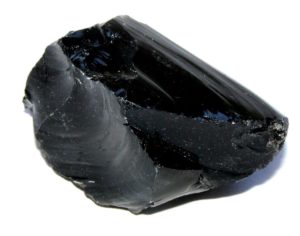
What is Obsidian?
Obsidian Rock
Color: Deep black or blackish green
Fracture: Conchoidal
Mohs scale hardness: 5 – 6
Luster: Vitreous
Specific gravity: c. 2.4
Optical properties: Translucent
Obsidian is a volcanic glass that occurs naturally as an extrusionary igneous rock.
Obsidian is a massive glass of volcanoes. This word is’ huge,’ but it does mean in geology that stone (obsidian is rocky, not a mineral) is homogeneous, though this is connected to geologies. Laying, slitting, leavening, phenocrysts, etc. is lacking. It is simply an unconditional piece of volcanic glass. Obsidian solidification (on earth) in most instances was subaerial. Underwater volcanic glass has alternative names such as tachyllite and hyaloclastic.
The volcanic glass and obsidian are therefore not synonymous, although you can often freely use both terms. You certainly do not use “volcanic glass” rather than “obsidian,” but be careful about it—volcanic glass isn’t always obsidian.
Volcano glass is an igneous rock made up of a magmatic content mainly uncrypted. Most of it is not crystallized because the crystals had two difficult problems which restricted their growth. It’s time the first. Large crystals have to develop for a long moment. When viscous magma is removed from a volcano and cools quickly, there’s very little. I gave a subtle indication of what might be the second issue. It is the viscosity of magma / lava. The crystals are very difficult to form if the magmatic body is thick and viscous, because they don’t have new material, when almost nothing can move inside the magma body.
So obsidian forms from viscous magma only? Often yes, but not always. The structure of most obsidians is rhyolitic. The thickest lava has the largest concentration of silica. Why does this matter? Since silica polymerizes magma. There are many bridges (chemical connections) between silica oxygen anions (SiO2), which is why it is so difficult to relocate this magma. If the water has many electrons (cations), it is less viscous, because the frame system of silica is broken by these cations.
How Obsidian is Formed?
Obsidian is created when the volcano’s felsic lava cools quickly with minimal crystal growth. The chemicals (hodium silica content) produce a elevated viscosity that shapes a natural glass from lava when rapidly drying. The chemical composition is often discovered on the edges of rhyolitic lava flows recognized as obsidian flows. The absence of crystal growth is explained by the inhibition of atomic diffusion by this high-viscous lava. Obsidian is difficult, fragile and amorphous and therefore has strong corners of fractures. The instruments for slicing and piercing were previously used and were used as operative scalpel blades experimentally.
The obsidian is the rock created by fast-cooled lava, the material father. Extensive obsidian formation can happen if felsic magma quickly recools on the corners of a volcanic dome or felsic lava stream, or if lava cools during abrupt water or wind touch. Obsidian can be intrusive when felsic lava cools on the edges of a deck.
Obsidian consists of approximately 70% or more of the silicone (silicone dioxide) that has been uncristallised. It is like granite and rhyolite, which were also initially frozen, chemically. As obsidian is not mineral crystals, it is not a real “stone” technically obsidian. It is actually a congealed fluid with small quantities of microscopic and impure microscopy. Obsidian with a typical hardness of 5 to 5.5 is comparatively gentle on the level of mineral hardness. In contrast, quartz (silicium dioxide crystallized) is of 7.0 hardness.
Why Obsidian is Black?
Pure obsidian is generally black, although the colour differs with the existence of impurity. The jade could be light gray to black with iron and other transformation components. The majority of black obsidians are magnetite-nanoinclusions, iron oxide. Very few obsidian specimens are almost colorless. In some rocks, the incorporation of the mineral cristobalitis in the black glass of tiny, yellow, radially grouped rocks produces a blotchy (snowflaking) image.
Obsidian can include patterns of gas bubbles from the lava flow that align with layers created during molten rock before cooling. These bubbles could generate exciting impacts like a golden blade (obsidian blade). The inclusion of magnetite nanoparticles, which create a thin-film interference, causes an iridescent, rainbow-like shine. Mexican colorful rainbow obsidian contains hedenbergite oriented nanorods which cause rainbow strewning effects via interference with thin films.
The various colors of obsidian are a result of several factors. There are very few clear obsidian types, or microscopic mineral crystals. Obsidian red or brown usually results in small crystals or hematite or limonite (iron oxide) inclusions. The jet-black types of obsidian are probable to generate abundant microscopic crystals of minerals such as magnet, hornblende, pyroxene, plagioclase, and biotites in combination with smaller pieces of rocken. The distinctive blue, green, violet or bronze colours of the rainbow obsidian may be obtained from a microscope of multiple feldspar kinds.
Where Obsidian is Found?
Obsidian can be discovered in places with rhyolitical temperatures. You can find it in Argentina, Australia, Chile, Azerbaijan, Armenia, Guatemala, Iceland, Mexico, New Zealand, Iceland, Peru, Greece, El Salvador, Turkey, Kenya, Mexico, Peru and New Zealand. In Cascade Range of the west of north America and in the south of California’s Sierra Nevada, Obsidian streams can be discovered within Newberry Volcano calderas and Medicine Lake Volcano. Yellowstone National Park is situated between Mammoth Hot Springs and the Norris Geyser Basin and has an obsidian mountain ranges and reservoirs in many other Western US States such as Arizona, Colorado, New Mexico, Texas, Utah, Washington, Oregon, and Idaho. The southern countries of Virginia, as well as Pennsylvania and North Carolina are also subject to obsidian.
In the main Mediterranean there are only four significant deposits: Lipari, Pantelleria, Palmarola and Monte Arci. Milos and Gyali were former suppliers in the Aegean.
The most significant springs in Central Anatolia, one of the main sources in the prehistorical Middle East, were the city Acıgöl and the Göllü Dağ volcano.










